That was one of the two most enjoyable parts of Days of Thunder. The other was the entire opening sequence, showing preparation of Daytona International Speedway for the Daytona 500. The sun rises; fans start coming into the speedway; the pit crews set up their spaces; and the cars line up for the start. Tension mounts throughout the entire sequence.
These two parts of the film are about preparation. Duvall shows viewers the concept, the dream, and the love of racing that yield what spectators eventually see on the track. The opening sequence is race day. It waits for no one; you have to be ready. It’s where Duvall’s dream takes flight.
The story of SRRT’s preparation of #35 takes place between concept (prior to the WRX STI Sedan reaching America’s shores) and track. Most of it involved intense, hard work that can be driven only by a love for motorsports. But that’s the singular path to perfection.
New York International Auto Show, April 2010
New York International Auto Show, April 2010
The 2011 WRX STI Sedan debuted at the New York International Auto Show on April 1, 2010. James Han, motorsports marketing manager for Subaru of America, Inc., Joe Aquilante, SRRT team principal, and John Heinricy, SRRT engineering director, attended the pre-
As Aquilante was examining the car for the first time, he was asked if the sedan body would make for a better road-
When did the sedan begin to become a reality for SRRT? According to James Han, “At the annual Subaru dealer meeting the third week in May.”
SRRT/Phoenix placed its order for its 2011 Subaru WRX STI in August. Andrew Aquilante recounts: “We started talking about what we were going to do next year in August or so, when James said we were going to run the 4-
“It’s been the Subaru halo car – the image of the STI has always been a 4-


PREPARATION OF A ROAD RACER


TALKING WITH JOE AND ANDREW AQUILANTE OF SUBARU PARTNER PHOENIX PERFORMANCE ABOUT SUBARU ROAD RACING TEAM’S (SRRT’S) NEW #35 WRX STI SEDAN, YOU GET THAT SAME FEELING AS WHEN WATCHING ROBERT DUVALL PLAYING HARRY HOGGE IN THE MOVIE DAYS OF THUNDER. HE’S ALONE WITH THE BARE FRAME OF A RACE CAR IN A BARN, AND HE TALKS TO IT ABOUT HOW HE’S GOING TO BUILD IT WITH ALL THE TRICKS HE’S LEARNED TO MAKE IT PERFECT.
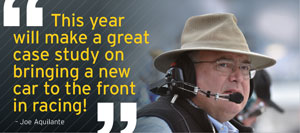
Preparation Prior to Delivery
SRRT’s red #35 WRX STI 5-
Late in 2010, Joe Aquilante commented, “This year will make a great case study on bringing a new car to the front in racing!”
Red #35 was competitive, and the team often vied with the leaders in the top 10.
“Since I wasn’t involved in any of the previous builds, I needed to take things apart and see where things went – label what wires we could cut out, and that sort of thing. I did most of the delicate disassembly, where stuff would be going back in, but in modified form in the sense of, ‘We’ve got to save these wires because they’re for the cluster, but we can get rid of these because they’re for the radio.’ I familiarized myself with what control boxes are where and that sort of thing.
System by System
Everything learned from the red #35 5-
Andrew Aquilante recalled, “The first thoughts about what we could do differently was probably when we placed the order. So August was when we started talking about, ‘OK, we want to do this differently. We have to build that differently.’
“The car arrived at the shop in September when we were at Miller [Motorsports Park – for the last GRAND-
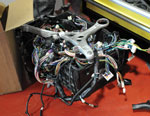
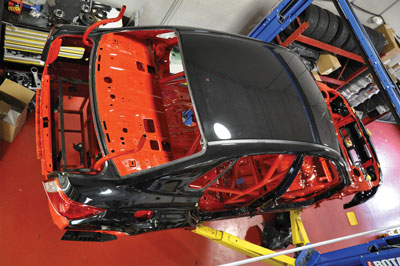
“Since we were taking the car to the SEMA [Specialty Equipment Market Association] Show, we had to get it done pretty quick. That was September 14, and it was on the truck October 20-
“It had to be disassembled, caged, painted, and rebuilt in five weeks.”
Disassembly included stripping the car to its unit body. Seats, carpeting, headliner, door panels, engine, transmission, suspension – everything was removed, including sealant and insulation.
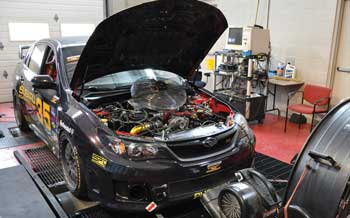
Roll cage fabrication as well as engine building are done on the Phoenix Performance premises, in space rented out by Phoenix. That saves time in the preparation and building/rebuilding processes. Phoenix also houses a full body shop, 4-
Andrew Aquilante continued, “The outside of the car was black. We painted the inside and the underneath red. That’s just how we prepare our cars – they’re black on the outside, and they always have a red interior because it stands out. It makes the car pop. It’s different.”
The black exterior was made even more distinct by a full body wrap that includes pinstripes along with yellow accents.
Although he didn’t do the fabricating or the painting, Andrew Aquilante did most of the assembly, modification of the wiring harnesses, reassembly of the dash, fabricating of the fill-
The completed race car met the 3,050-
Concerning major changes between last year’s red #35 and the new sedan, Andrew Aquilante commented, “Some of the major changes were attention to detail in the build and small changes that may or may not have too much of an effect. For instance, the car ended up probably 50 pounds lighter from being more attentive to wiring and other stuff going into it that didn’t need to. We had a different fuel cell arrangement inside the tank to make sure we get every last drop out of it, different fuel pumps, different ways of wiring and cleaning up the stock wiring, and usingdifferent seatbelts. We were just trying to look at it and saying, ‘Where can we save weight?’
“We’ll be at minimum weight, even though the Subaru with stock body panels is challenging to get under 3,000 pounds.”
At SEMA in Las Vegas the first week of November, #35 was approximately 90 percent finished. (Read more about the car at the show in the Editor’s Track Journal entry for November 5, 2010.

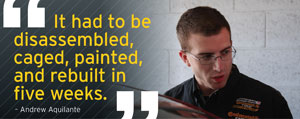
Testing in Florida
After the show, the car was immediately shipped east, where SRRT/Phoenix made final preparations for testing during a GRAND-
The team was pleased by #35’s showing at Homestead, where it ran in the top five during the test sessions and posted top times.
A few weeks later, SRRT returned to Florida January 7 to 9, 2011, for GRAND-
GRAND-
The true test of a car’s (and a team’s) mettle is in the racing. With all systems finally in place, running race tires and proper turbocharger setups, SRRT practiced, qualified, and raced the first event on the GRAND-
After resolving a cooling problem in the opening laps that placed it at the end of the Grand Sport class, the team took #35 through the 33-
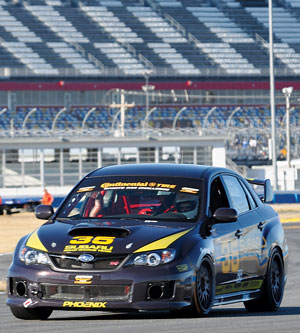

To see more images of #35 and the team on the test days, click here.
To see more images of #35 and the team from the GRAND-

Joe Aquilante, president (610) 482-
© Phoenix Performance, LLC
(for best results, set pop-

| Phoenix Performance LLC Home |
| Phoenix in the News |
| Map & Directions |
| Services |
| Facilities : Shop |
| 2023 Phoenix Brochure |
| Phoenix Performance Racing |
| Services |
| 2023 Race Schedule, Results, Updates |
| Crew |
| Racecars |
| 2023 Videos |
| 2024 Videos |
| 2024 Photos |
| Videos |
| Drivers |
| Archive |
| Andrew Aquilante |
| Kurt Rezzetano |
| Mashall Mast |
| Archive (drivers) |
| pre-2016 Race Schedule & Media |
| pre-2016 Race Gallery |
| Phoenix Subarus in the News |
| Joe Aquilante |
| John Heinricy |
| Bret Spaude |
| Kristian Skavnes (2009) |
| Don Knowles |
| Preston Calvert |
| Jeff Altenberg |
| PAM 2015 Gallery |
| PAM 2014 Gallery |
| PPR 2013 Gallery |
| SRRT 2012 Gallery |
| SRRT 2011 Gallery |
| SRRT 2010 Gallery |
| SRRT 2009 Gallery |
| 2008-2011 Gallery |
| 2007 & 2008 Gallery |
| Phoenix Cars for Sale |
| Phoenix Parts for Sale |







